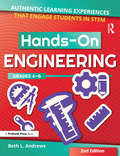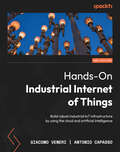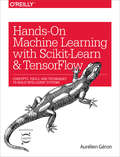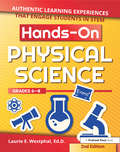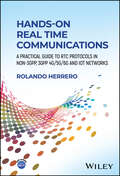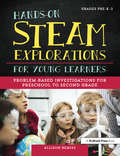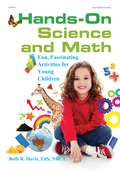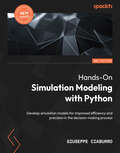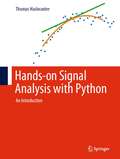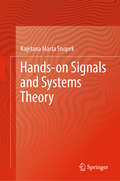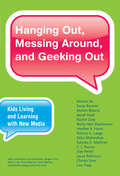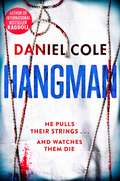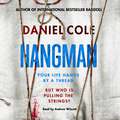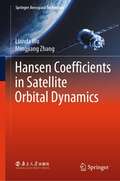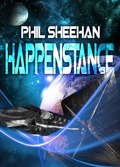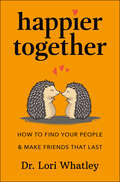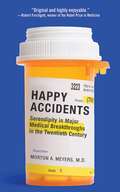- Table View
- List View
Hands-On Engineering: Authentic Learning Experiences That Engage Students in STEM (Grades 4-6)
by Beth L. AndrewsHands-On Engineering immerses students in the world of real-life engineers. Through engaging authentic learning experiences, students will create innovative solutions to relevant and timely design and engineering challenges while building STEM skills. This book is packed with activities that can be easily conducted in the classroom using everyday materials and includes everything teachers need to help students think analytically, assess new situations, and solve hands-on, real-world problems. From engaging in practical problem solving and collaboration to employing imagination and perseverance, students will not just learn about engineering—they will be engineers!Grades 4-6
Hands-On Industrial Internet of Things: Build robust industrial IoT infrastructure by using the cloud and artificial intelligence
by Giacomo Veneri Antonio CapassoBuild scalable, secure, and intelligent systems by utilizing IoT architectures, AWS, Azure, AI, and real-world solutions to become a skilled IIoT architectKey FeaturesLeverage IoT, AI/ML, and cloud technologies to unlock industrial potential and drive business innovationWork with labs on real-world edge computing scenarios, integrating AWS, Azure, and open source toolsUse diagnostic and predictive analytics to develop digital twins, improve industrial processes, and manage assetsPurchase of the print or Kindle book includes a free PDF eBookBook DescriptionIn today's automation-driven era, precision is crucial, and the Industrial Internet of Things (IIoT) has made a remarkable impact. This updated second edition explores the technologies fueling the IIoT revolution and shares essential knowledge to enable you to establish remote-access networks. Written by IIoT and AI experts, as well as renowned authors, this book helps you enhance your skills in emerging technologies by introducing new techniques from Azure and AWS and keeping you up to date with the latest advancements. You'll find out how Artificial Intelligence of Things (AIoT) and MLOps apply to IIoT and learn how to handle complex projects confidently. The book covers identifying and connecting industrial data sources from various sensors, advancing from foundational concepts to professional skills. You'll discover how to connect these sensors to cloud networks such as AWS IoT, Azure IoT, and open source IoT platforms, and extract data from the cloud to your devices. Through hands-on experience with tools such as Node-RED, OPC UA, MQTT, NoSQL, defense in depth, and Python, you'll develop streaming and batch-based AI algorithms. By the end of this book, you'll have achieved a professional level of expertise in the cloud, IoT, and AI, and be able to build more robust, efficient, and reliable IoT infrastructure for your industry.What you will learnGet a solid understanding of industrial processes, devices, and protocolsHarness IoT technology to effectively manage industrial use casesDesign and implement an IIoT network flow to continuously monitor the performance of your critical assetsGet to grips with popular cloud-based platforms such as AWS and AzureExplore Edge devices and learn about Edge and fog computing to gather field dataApply diagnostic analytics to real-world data to answer critical workforce questionsDevelop AIoT technology for predictive maintenanceWho this book is forIf you are an IoT architect, developer, AI engineer, or stakeholder involved in designing the architecture systems of the Industrial Internet of Things, this book is for you. The only prerequisite needed is a solid understanding of the Python programming language and networking concepts.
Hands-On Machine Learning with Scikit-Learn and TensorFlow: Concepts, Tools, and Techniques to Build Intelligent Systems
by Aurélien GéronGraphics in this book are printed in black and white.Through a series of recent breakthroughs, deep learning has boosted the entire field of machine learning. Now, even programmers who know close to nothing about this technology can use simple, efficient tools to implement programs capable of learning from data. This practical book shows you how.By using concrete examples, minimal theory, and two production-ready Python frameworks—scikit-learn and TensorFlow—author Aurélien Géron helps you gain an intuitive understanding of the concepts and tools for building intelligent systems. You’ll learn a range of techniques, starting with simple linear regression and progressing to deep neural networks. With exercises in each chapter to help you apply what you’ve learned, all you need is programming experience to get started. Explore the machine learning landscape, particularly neural nets; Use scikit-learn to track an example machine-learning project end-to-end; Explore several training models, including support vector machines, decision trees, random forests, and ensemble methods; Use the Tensor; Flow library to build and train neural nets; Dive into neural net architectures, including convolutional nets, recurrent nets, and deep reinforcement learning; Learn techniques for training and scaling deep neural nets; and apply practical code examples without acquiring excessive machine learning theory or algorithm details.
Hands-On Physical Science: Authentic Learning Experiences That Engage Students in STEM (Grades 6-8)
by Laurie E. WestphalHands-On Physical Science immerses students in the world of real-life chemists and physicists. Through engaging authentic learning experiences, students will engage in fascinating experiments while building STEM skills. This book is packed with activities that can easily be conducted in the classroom using everyday materials and includes everything teachers need to help students think critically and problem solve as they explore the fascinating world of physical science. From examining Newton's laws using sports video clips to studying energy through the design and building of roller coasters, students will not just learn about physical science—they will be scientists!Grades 6-8
Hands-On Real Time Communications: A Practical Guide to RTC Protocols in Non-3GPP, 3GPP 4G/5G/6G and IoT Networks
by Rolando HerreroUnderstand and deploy RTC protocols for any kind of communication system Since the emergence of Voice over IP (VoIP) communications in the late 1990s, a set of real time communication (RTC) protocols has evolved that together now support an immense range of technologies and systems architectures. Whether it’s 5G networks (and beyond) or Internet of Things architectures, RTC protocols are indispensable to modern telecommunications. An understanding of these protocols and their design and deployment is critical for engineers, academics, and industry professionals in virtually every connected field. Hands-On Real Time Communications offers a thorough yet accessible introduction to this subject, incorporating both the theory and practical applications of RTC protocols. It offers detailed instructions for deploying RTC protocols on various types of network stacks, as well as the use of a huge range of speech, audio, and video codecs. Practice-oriented and designed for students as well as established professionals, it’s a must-own for anyone looking to deploy and maintain essential communications architectures. Readers will also find: A matching hands-on section for each theoretical aspect, incorporating license-free protocol analyzers and emulation toolsDetailed discussion of topics including signaling, media packetization, real hardware-based network interfaces, and many moreEnd-of-chapter questions and lab exercises to facilitate learning Hands-On Real Time Communications is ideal for advanced undergraduate or graduate students in RTC communication and networking classes, as well as for engineers, technologists, and architects looking to learn and understand the principles of RTC networking.
Hands-On STEAM Explorations for Young Learners: Problem-Based Investigations for Preschool to Second Grade
by Allison BemissHands-On STEAM Explorations for Young Learners: Problem-Based Investigations for Preschool to Second Grade uses popular children's nursery rhymes to explore STEAM concepts through minds-on, hands-on investigations. Children ages 4-8 and their teachers will love this twist on familiar old nursery rhymes. Children will enjoy problem solving and tinkering as they discover and explore. Baa, Baa, Black Sheep insists that she hides more colors in the drawn lines of her black wool. Test to find out if it is possible for black to be more than one color. How might you make Old King Cole's fiddle using cardboard boxes and rubber bands? Teachers will appreciate the easy-to-follow layout, connections to advanced learning, and easy-to-access materials in each investigation. Innovation, wonder, and fun are at the heart of each of these explorations.Grades Pre-K-2
Hands-On Science and Math: Fun, Fascinating Activities for Young Children
by Beth R. DavisEncourage young investigators to feel, listen, smell, taste, and see their way to discovery by seamlessly infusing math and science throughout the school day! As you incorporate all five senses into learning experiences, you will give little innovators the opportunity to observe and explore the world around them. The activities in Hands-On Science and Math: Fun, Fascinating Activities for Young Children will help you plan engaging science, technology, engineering, and math (STEM) lessons that will excite children and foster their critical thinking. Children can experience the thrill of scientific inquiry through simple experiments. Designed to work with easy-to-find materials, the Hands-On Science and Math activities are inexpensive and uncomplicated, yet they lay the groundwork for understanding more complex STEM concepts later on.
Hands-On Simulation Modeling with Python: Develop simulation models for improved efficiency and precision in the decision-making process, 2nd Edition
by Giuseppe CiaburroLearn to construct state-of-the-art simulation models with Python and enhance your simulation modelling skills, as well as create and analyze digital prototypes of physical models with easeKey FeaturesUnderstand various statistical and physical simulations to improve systems using PythonLearn to create the numerical prototype of a real model using hands-on examplesEvaluate performance and output results based on how the prototype would work in the real worldBook DescriptionSimulation modelling is an exploration method that aims to imitate physical systems in a virtual environment and retrieve useful statistical inferences from it. The ability to analyze the model as it runs sets simulation modelling apart from other methods used in conventional analyses. This book is your comprehensive and hands-on guide to understanding various computational statistical simulations using Python. The book begins by helping you get familiarized with the fundamental concepts of simulation modelling, that'll enable you to understand the various methods and techniques needed to explore complex topics. Data scientists working with simulation models will be able to put their knowledge to work with this practical guide. As you advance, you'll dive deep into numerical simulation algorithms, including an overview of relevant applications, with the help of real-world use cases and practical examples. You'll also find out how to use Python to develop simulation models and how to use several Python packages. Finally, you'll get to grips with various numerical simulation algorithms and concepts, such as Markov Decision Processes, Monte Carlo methods, and bootstrapping techniques.By the end of this book, you'll have learned how to construct and deploy simulation models of your own to overcome real-world challenges.What you will learnGet to grips with the concept of randomness and the data generation processDelve into resampling methodsDiscover how to work with Monte Carlo simulationsUtilize simulations to improve or optimize systemsFind out how to run efficient simulations to analyze real-world systemsUnderstand how to simulate random walks using Markov chainsWho this book is forThis book is for data scientists, simulation engineers, and anyone who is already familiar with the basic computational methods and wants to implement various simulation techniques such as Monte-Carlo methods and statistical simulation using Python.
Hands-on Signal Analysis with Python: An Introduction
by Thomas HaslwanterThis book provides the tools for analyzing data in Python: different types of filters are introduced and explained, such as FIR-, IIR- and morphological filters, as well as their application to one- and two-dimensional data. The required mathematics are kept to a minimum, and numerous examples and working Python programs are included for a quick start. The goal of the book is to enable also novice users to choose appropriate methods and to complete real-world tasks such as differentiation, integration, and smoothing of time series, or simple edge detection in images. An introductory section provides help and tips for getting Python installed and configured on your computer. More advanced chapters provide a practical introduction to the Fourier transform and its applications such as sound processing, as well as to the solution of equations of motion with the Laplace transform. A brief excursion into machine learning shows the powerful tools that are available with Python. This book also provides tips for an efficient programming work flow: from the use of a debugger for finding mistakes, code-versioning with git to avoid the loss of working programs, to the construction of graphical user interfaces (GUIs) for the visualization of data. Working, well-documented Python solutions are included for all exercises, and IPython/Jupyter notebooks provide additional help to get people started and outlooks for the interested reader.
Hands-on Signals and Systems Theory
by Kajetana Marta SnopekThis textbook presents the theory of continuous-time and discrete-time signals and systems and shows how it can be used to solve analytically different problems. The book is dedicated to engineering students who are interested in mathematical methods used to solve real technical problems connected with signals and systems. The book covers, both in continuous- and in discrete domains, analysis of signals in time domain; orthogonal signal representation including Fourier series; convolution and correlation of signals; analysis of signals in the frequency domain and signal sampling, including aliasing and stroboscopic effects, among others. The author also emphasizes the role of Fourier-, one-sided Laplace- and one-sided Z transformations in signals and systems. Chosen methods of analog and digital filter design and stability criteria of analog and digital filters are also described. The author presents the necessary theory in the form of a concise “lecture” accompanied with a number of solved original problems. Every chapter ends with examples of complete solutions with explanation and necessary graphical visualization (graphs, schemes etc.).
Hanging Out, Messing Around, and Geeking Out: Kids Living and Learning with New Media (The John D. and Catherine T. MacArthur Foundation Series on Digital Media and Learning)
by Danah Boyd Mizuko Ito Sonja Baumer Matteo Bittanti Rachel CodyAn examination of young people's everyday new media practices—including video-game playing, text-messaging, digital media production, and social media use.Conventional wisdom about young people's use of digital technology often equates generational identity with technology identity: today's teens seem constantly plugged in to video games, social networking sites, and text messaging. Yet there is little actual research that investigates the intricate dynamics of youths' social and recreational use of digital media. Hanging Out, Messing Around, and Geeking Out fills this gap, reporting on an ambitious three-year ethnographic investigation into how young people are living and learning with new media in varied settings—at home, in after-school programs, and in online spaces.Integrating twenty-three case studies—which include Harry Potter podcasting, video-game playing, music sharing, and online romantic breakups—in a unique collaborative authorship style, Hanging Out, Messing Around, and Geeking Out is distinctive for its combination of in-depth description of specific group dynamics with conceptual analysis.
Hangman: A gripping detective thriller from the bestselling author of Ragdoll (A Ragdoll Book #2)
by Daniel ColeMeet DCI Emily Baxter, a detective whose life is as complicated as the cases she investigates. An action-packed serial killer thriller for fans of Tess Gerritsen, MJ Arlidge and LJ RossA body is found hanging from Brooklyn Bridge, the word 'BAIT' carved into the chest. In London a copycat killer strikes, branded with the word 'PUPPET', forcing DCI Emily Baxter into an uneasy partnership with the detectives on the case, Special Agents Rouche and Curtis. Each time they trace a suspect, the killer is one step ahead. With the body count rising on both sides of the Atlantic, can they learn to trust each other and identify who is holding the strings before it is too late? ************** CRIME READERS ARE GRIPPED BY HANGMAN: 'What a thrill! This book grabbed me from the beginning'- Netgalley reviewer 'I could not put down this book' - Netgalley reviewer'A cracking thriller, fast-paced and gripping' - Netgalley reviewer'Baxter was a brilliantly well written character' - Amazon reviewer'I love Baxter's sass!' - Amazon reviewer
Hangman: A gripping detective thriller from the bestselling author of Ragdoll (A Ragdoll Book #2)
by Daniel ColeEighteen months have passed, but the scars the Ragdoll murders left behind are reopened on a daily basis, the legacy of the infamous investigation infecting all aspects of daily life. Despite the media's best efforts, copycat murders all over the planet have proven to be nothing more than violent mutilations by the unimaginative and deranged. Andrea Hall's memoirs are topping the charts while Halloween saw children all over the country distastefully donning grotesque costumes of the real-life monster in their midst. The Ragdoll, apparently, was here to stay.Over-promoted into the role of Chief Inspector following her work on the case, Emily Baxter is ill-suited to her new bureaucratic posting. Alex Edmunds won't admit it, but he is bored too, having returned to his monotonous job in Fraud after fighting so hard to escape. When Baxter is summoned to a meeting with Special Agents Elliot Curtis of the FBI and Damien Rouche of the CIA, she is presented with graphic photographs of the latest copycat murder: a body contorted into a familiar pose, strung up impossibly across the Brooklyn Bridge, the word BAIT carved deep into its chest. The victim's name: William Fawkes, a Wall Street banker and a very clear message that this murder is different to the others.Baxter is ordered to assist the unrelentingly professional Curtis and the charmingly eccentric Rouche with their investigation, another PR exercise to appease the ever-demanding public. Accompanying them to New York and the scene of another murder, they find the same word scrawled across the victim, torn into the assailant - the word PUPPET. The team helplessly play catch up as the murders continue to grow in both spectacle and depravity on both sides of the Atlantic, building towards a devastating crescendo. Their only hope: to work out who the bait is intended for, how the Puppets are chosen but, most importantly of all, who is holding the strings.Read by Andrew Wincott(p) Orion Publishing Group 2018
Hansen Coefficients in Satellite Orbital Dynamics (Springer Aerospace Technology)
by Mingjiang Zhang Lianda WuThis book highlights the systematic investigation into the calculation of Hansen coefficients and their derivatives in satellite orbital dynamics. Direct, recurrence and other types of calculation methods of Hansen coefficients and their derivatives are comprehensively presented. The calculation in motion theory without singularities is particularly discussed. From the perspective of accuracy and efficiency, the advantages and disadvantages of various calculation methods are compared and analyzed, and some improvements are proposed. This book is intended for graduate students and researchers engaged in astronomy, space science, and geodesy. One can choose from the calculation methods of Hansen coefficients and their derivatives presented in this book to meet their practical needs.
Happenstance (The Happenstance Series)
by Phil Sheehan&“[A] 5-star, science fiction-techno thriller story filled with twists and turns, excitement, action, adventure and a . . . thought-provoking storyline.&”—Artisan Book ReviewsUnaware that it&’s about to be thrust into the middle of a centuries-old cosmic conflict, Earth discovers an unknown object spotted near Pluto, followed by another on Mars. A team of experts on the maiden flight of a first-of-its-kind spaceship are sent to investigate. Sabotage threatens the mission and the security of the United States as the president and his advisors search for solutions. With enemies on fronts both terrestrial and otherwise, the stakes soon become apparent to a nation embroiled in a conflict unlike anything it has faced before. Far from Earth, Major Blake Thompson and his specialized SEAL team investigate the strange objects. As the nature of the threat is uncovered and the stakes continue to mount, they risk everything to prevent the world from a catastrophic level of destruction that would change the course of humanity forever. Yet even if they succeed, at what cost?&“A gripping action novel with well-integrated science fiction elements. For readers who prize excitement above all else, this is a great choice.&”—OnlineBookClub.org
Happier Together: How to Find Your People & Make Friends That Last
by Lori WhatleyHappier Together is a must-read exploration of the transformative power of authentic human connection and the detrimental effects of loneliness.Happier Together celebrates the value of friendships at every stage of life and their role in creating a strong foundation for health, happiness, and longevity. Essential for anyone looking to overcome loneliness, Happier Together details the how, when and where to find friends, start new relationships and nurture existing connections.Discover in these pages:• The Transformative Power of Connection: How meaningful connections improve well-being and longevity.• Health Risks of Loneliness: The severe physical and mental health risks associated with social isolation.• Importance of Friendships: The critical role of friendships in living a long and fulfilling life.• Research-Based Insights: Evidence-based findings on the impact of social media on mental health and interpersonal relationships.• Practical Advice: Strategies for building and maintaining strong, supportive relationships.In today's world, we can often feel disconnected and lonely. Our interactions are increasingly digital, leading to impersonal interactions that fail to satisfy our essential need for real connection.Happier Together is a powerful reminder that fostering meaningful relationships is essential for our well-being. By understanding the importance of friendship and actively working to build and maintain these connections, we can lead longer, more fulfilling lives.
Happy Accidents: Serendipity in Major Medical Breakthroughs in the Twentieth Century
by Morton A. MeyersHappy Accidents is a fascinating, entertaining, and highly accessible look at the surprising role serendipity has played in some of the most important medical discoveries in the twentieth century. What do penicillin, chemotherapy drugs, X-rays, Valium, the Pap smear, and Viagra have in common? They were each discovered accidentally, stumbled upon in the search for something else. In the 1990s, Pfizer had high hopes for a new drug that would boost blood flow to the heart. As they conducted trials on angina sufferers, researchers noted a startling effect: while the drug did not affect blood flow to the heart, it did affect blood flow elsewhere! Now over six million American men have taken Viagra in their lifetime.Winston Churchill once said, "Men occasionally stumble across the truth, but most of them pick themselves up and hurry off as if nothing has happened." Within the scientific community, a certain stigma is attached to chance discovery because it is wrongly seen as pure luck. Happy accidents certainly happen every day, but it takes intelligence, insight, and creativity to recognize a "Eureka, I found what I wasn't looking for!" moment and know what to do next. In discussing medical breakthroughs, Dr. Morton Meyers makes a cogent, highly engaging argument for a more creative, rather than purely linear, approach to science. And it may just save our lives!
Happy Paws: A Branches Book (Layla and the Bots #1)
by Vicky FangMeet rock star Layla and her team of Bots!Pick a book. Grow a Reader!This series is part of Scholastic's early chapter book line Branches, aimed at newly independent readers. With easy-to-read text, high-interest content, fast-paced plots, and illustrations on every page, these books will boost reading confidence and stamina. Branches books help readers grow!Layla and the Bots are in an awesome rock band! They also use problem-solving and creativity to build cool inventions. When a local amusement park is in danger of shutting down, Layla knows just how to bring in the crowds... build an amusement park for DOGS! But will cool doggie rides like the Rub-a-Dub Mud Slide and the Tummy Rubbing Machine be enough to keep the park open? With full-color artwork on every page and speech bubbles throughout, this early chapter book series brings kid-friendly STEAM topics to young readers!
Happy Pigs Taste Better: A Complete Guide to Organic and Humane Pasture-Based Pork Production
by Alice PercyWhat does it take to raise a happy pig? Armed with experience from running the largest organic hog operation in Maine, author Alice Percy is well equipped to answer this question.Pigs are much closer to their cousin, the wild boar, than other domesticated animals. Ethically managing pigs requires an understanding of their natural mannerisms, including factors such as social grouping, mating, territory, housing, and, of course, their love of wallowing in the mud.In Happy Pigs Taste Better Percy offers a comprehensive look at raising organic, pasture-fed, gourmet meat. She advises readers on pasturing and feeding hogs organically, as well as managing the breeding herd and administering effective natural healthcare. In addition, she provides an overview of marketing and distribution for those looking to turn their hog farming operation into a lucrative business.This book is the first of its kind to offer an in-depth approach to organic, high-welfare commercial production, including information on:– Designing a hog business from the ground up– Housing pigs, including benefits and drawbacks of various housing systems– Evaluating the nutritional content of common organic feedstuffs– Butchering humanely and economically– Recordkeeping, with templates for financial trackingWhether you&’re looking to convert a conventional operation to organic, grow your backyard hog operation into a viable business, or start from scratch, this comprehensive book has got you covered, nose to tail.
Happy Tails Lodge: A QUIX Book (Fort Builders Inc. #2)
by Dee RomitoThe enterprising kids of Fort Builders, Inc., are at it again. This time, the friends use their creativity and construction know-how to build a pet palace in the second story in the fun-to-read Aladdin QUIX chapter book series that&’s perfect for emerging readers!Jax and his twin sisters are getting kittens! The new four-legged members of the family will be coming home any day. And Fort Builders, Inc., has a new project…pet forts! Together, they know they can come up with the purr-fect hangout for the tiny felines. But they hit a major snag in their testing phase. None of the forts they test out is quite right. Can the team manage to build the best pet palace imaginable in time for the kittens&’ arrival?
Happy Town
by Greg van EekhoutStay calm and remain HAPPY. Help is on the way. Perfect for fans of Gordon Korman and Jennifer L. Holm, this adventure-packed middle grade story, set in a world not too far from our own, follows a family that moves to a remote company town that seems perfect on the surface....Keegan knows there’s something off about Happy Town.The isolated, high-tech company town is too perfect—with a dome keeping out bad weather and self-driving vehicles rumbling throughout the town delivering residents to work and school. Still, Keegan is excited to grow his art skills at Happy Town’s ultra-modern middle school, even if he has less time to see his mom and stepdad because of their new jobs.But when the two become obsessed with working and eating Happy Corp Meat Cramwich (the Microwaveable Sandwich Crammed with Meat) and Keegan gets sentenced to Mandatory Work Opportunities for refusing to follow Happy Town’s shady rules, he discovers a dangerous glitch in the system that’s turning the town’s happy residents into zombies. Carnivorous, meat-craving, literal zombies. With his new friends Gloriana and Tank by his side, he’ll need to find a way to destroy Happy Town’s happy system—before there’s nothing left.
Haptic Feedback Teleoperation of Optical Tweezers
by Stéphane Régnier Ryad Benosman Céline Pacoret Zhenjiang NiThe authors of this book provide the first review of haptic optical tweezers, a new technique which brings together force feedback teleoperation and optical tweezers.This technique allows users to explore the microworld by sensing and exerting piconewton-scale forces with trapped microspheres. The design of optical tweezers for high-quality haptic feedback is challenging, given the requirements for very high sensitivity and dynamic stability. The concept, design process and specification of optical tweezers reviewed throughout this book focus on those intended for haptic teleoperation. The authors provide two new specific designs as well as the current state of the art. Furthermore, the remaining important issues are identified for further developments. Haptic optical tweezers will soon become an invaluable tool for force feedback micromanipulation of biological samples and nano- and micro-assembly parts.
Haptic Interaction
by Hiroyuki Kajimoto Hideyuki Ando Ki-Uk KyungThis book is aimed not only at haptics and human interface researchers, but also at developers and designers from manufacturing corporations and the entertainment industry who are working to change our lives. This publication comprises the proceedings of the first International AsiaHaptics conference, held in Tsukuba, Japan, in 2014. The book describes the state of the art of the diverse haptics- (touch-) related research, including scientific research into haptics perception and illusion, development of haptics devices, and applications for a wide variety of fields such as education, medicine, telecommunication, navigation, and entertainment.
Haptic Interaction
by Hiroyuki Kajimoto Ki-Uk Kyung Masashi Konyo Shoichi Hasegawa Takuya NojimaThis book is aimed not only at haptics and human interface researchers, but also at developers and designers from manufacturing corporations and the entertainment industry who are working to change our lives. This publication comprises the proceedings of the first International AsiaHaptics conference, held in Tsukuba, Japan, in 2014. The book describes the state of the art of the diverse haptics- (touch-) related research, including scientific research into haptics perception and illusion, development of haptics devices, and applications for a wide variety of fields such as education, medicine, telecommunication, navigation, and entertainment.
Haptic Interaction with Deformable Objects
by Guido BöttcherThe focus from most Virtual Reality (VR) systems lies mainly on the visual immersion of the user. But the emphasis only on the visual perception is insufficient for some applications as the user is limited in his interactions within the VR. Therefore the textbook presents the principles and theoretical background to develop a VR system that is able to create a link between physical simulations and haptic rendering which requires update rates of 1\,kHz for the force feedback. Special attention is given to the modeling and computation of contact forces in a two-finger grasp of textiles. Addressing further the perception of small scale surface properties like roughness, novel algorithms are presented that are not only able to consider the highly dynamic behaviour of textiles but also capable of computing the small forces needed for the tactile rendering at the contact point. Final analysis of the entire VR system is being made showing the problems and the solutions found in the work
